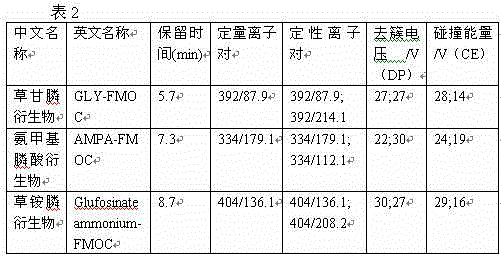Pretreatment method for measuring pesticides of glyphosate and phosphinothricin in tea leaves
A technology of glyphosate and glufosinate, applied in measuring devices, instruments, scientific instruments, etc., can solve the problems of interfering with the formation of reaction products, affecting the qualitative and quantitative of glyphosate and glufosinate, and reducing impurities. Interference, high sensitivity, method accurate effect
- Summary
- Abstract
- Description
- Claims
- Application Information
AI Technical Summary
Problems solved by technology
Method used
Image
Examples
Embodiment 1
[0014] A pretreatment method for measuring glyphosate and glufosinate pesticides in tea leaves is carried out through the following steps:
[0015] (1) Extraction: Weigh 2.0 g of tea samples into a 50 mL centrifuge tube, add 15 mL of 0.5 mol / L KOH solution, adjust the pH to above 13, shake well and let stand for 30 min. Centrifuge at 4000 rpm for 10 min, filter to obtain the filtrate, take 3 mL of the filtrate to a 10 mL centrifuge tube, add 5 mol / L hydrochloric acid solution and 0.5 mL strong acid solution to adjust the pH of the sample solution to below 7, shake evenly, and centrifuge at 4000 rpm for 10 min to obtain the extracted liquid.
[0016] (2) Purification: pipette 1 mL of the supernatant after extraction to a 60 mg oasis HLB solid-phase extraction column as 60 mg HLB filler (activation of the column: first add 2 mL of methanol to rinse, then add 2 mL of water to activate), Solid phase extraction is carried out to obtain a solid phase extract. The oasis HLB solid-p...
Embodiment 2
[0018] Example 2 Determination method for glufosinate-ammonium, glyphosate and aminomethylphosphonic acid residues-liquid chromatography-tandem mass spectrometry
[0019] 1. scope
[0020] It is suitable for qualitative identification and quantitative determination of glufosinate, glyphosate and aminomethylphosphonic acid residues in green tea, black tea, Puer tea and oolong tea. The detection limits of glufosinate-ammonium, glyphosate and aminomethylphosphonic acid are 0.075mg / kg, 0.050mg / kg and 0.050mg / kg respectively.
[0021] 2. method summary
[0022] The sample was extracted by potassium hydroxide solution, purified by HLB column, derivatized by FMOC-CL, detected by ultra-high pressure liquid chromatography-tandem mass spectrometer, and quantified by external standard method.
[0023] 3. Reagents and Materials
[0024] Water is secondary ultrapure water, unless otherwise specified, all reagents are analytically pure. Methanol (purified by liquid chromatogra...
Embodiment 3
[0068] Accurately weigh 2.0 g of organic tea samples into a 50 mL centrifuge tube, add the mixed standard at a concentration equivalent to 0.8 mg / kg, add 15 mL of water, shake well and let stand for 30 min. After centrifugation at 4000 rpm for 10 min, the filtrate was obtained by filtration.
[0069] Pipette 1 mL of the extract to a 60 mg HLB solid-phase extraction cartridge (column activation: first add 2 mL of methanol to rinse, then add 2 mL of water to activate), transfer the post-column filtrate to a 5 mL centrifuge tube, add 1 mol / Shake 0.25 mL of L KOM solution, then add 0.48 mL sodium borate buffer solution, shake well and add 0.18 mL FMOC-CL derivative solution, shake well and let stand overnight. The derivatized liquid sample was centrifuged at 10,000 rpm for 10 min, and passed through a 0.45 μm water filter membrane for analysis by liquid chromatography-tandem mass spectrometry.
[0070] Since this example only uses water as the extraction sol...
PUM
 Login to View More
Login to View More Abstract
Description
Claims
Application Information
 Login to View More
Login to View More - R&D
- Intellectual Property
- Life Sciences
- Materials
- Tech Scout
- Unparalleled Data Quality
- Higher Quality Content
- 60% Fewer Hallucinations
Browse by: Latest US Patents, China's latest patents, Technical Efficacy Thesaurus, Application Domain, Technology Topic, Popular Technical Reports.
© 2025 PatSnap. All rights reserved.Legal|Privacy policy|Modern Slavery Act Transparency Statement|Sitemap|About US| Contact US: help@patsnap.com



